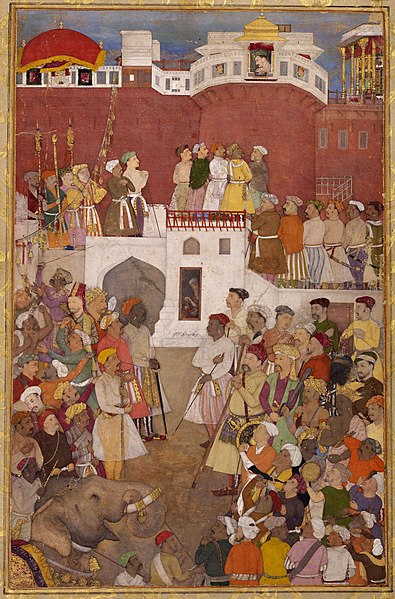Company style, also known as Company painting is a term for a hybrid Indo-European style of paintings made in British India by Indian artists, many of whom worked for European patrons in the East India Company or other foreign Companies in the 18th and 19th centuries. The style blended traditional elements from Rajput and Mughal painting with a more Western treatment of perspective, volume and recession. Most paintings were small, reflecting the Indian miniature tradition, but the natural history paintings of plants and birds were usually life size.
Group of Courtesans, Sikh Empire 1800–1825, 26 cm × 31.2 cm (10.2 in × 12.3 in) opaque watercolour and gold on paper
Khan Bahadur Khan with Men of his Clan, c. 1815, from the Fraser Album
Great Indian Fruit Bat (Pteropus giganteus), Bhawani Das or follower, 1777–82, from Mary Impey's album of natural history paintings
A Green-Winged Macaw, folio from Mary Impey's album of natural history paintings, Attributed by inscription to Shaikh Zain al-Din, Calcutta, about 1780
Mughal painting is a South Asian style of painting on paper confined to miniatures either as book illustrations or as single works to be kept in albums (muraqqa), originating from the territory of the Mughal Empire in the Indian subcontinent. It emerged from Persian miniature painting and developed in the court of the Mughal Empire of the 16th to 18th centuries. Battles, legendary stories, hunting scenes, wildlife, royal life, mythology, as well as other subjects have all been frequently depicted in paintings.
Govardhan, Emperor Jahangir visiting the ascetic Jadrup, c. 1616–1620
The Emperor Shah Jahan standing on a globe, with a halo and European-style putti, c. 1618–19 to 1629
Abu'l Hasan, Emperor Jahangir at the Jharoka window of the Agra Fort, c. 1620, Aga Khan Museum
Nilgai by Ustad Mansur (fl. 1590–1624), who specialized in birds and animal studies for albums








